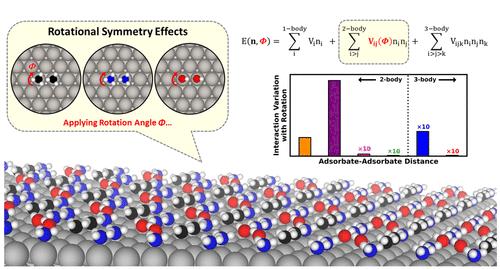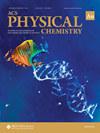旋转对称性对异质界面共吸附剂之间多体侧向相互作用的影响
IF 3.7
Q2 CHEMISTRY, PHYSICAL
引用次数: 0
摘要
异质界面在广泛的应用中至关重要,其材料特性可通过改变化学吸附剂的覆盖范围和构型进行调整。然而,由于对吸附剂内部结构和旋转对称性对助吸附剂之间横向相互作用的影响缺乏了解,这种吸附层的可调性受到了限制。利用密度泛函理论(DFT)和团簇展开,我们系统地确定了旋转对称性作为 DFT 函数、吸附剂类型、金属类型和团簇构型的函数对助吸附剂之间横向相互作用的影响。结果表明,旋转对称性的影响几乎完全可以划分到最短的 2 体簇中。通过电子分析,这种横向相互作用效应的性质和强度归因于依赖于吸附剂和金属类型的排斥和吸引静电相互作用的平衡。总之,我们对吸附剂内部结构和旋转对称性对横向相互作用影响的描述,提高了异质界面多体吸附剂多尺度建模的准确性。本文章由计算机程序翻译,如有差异,请以英文原文为准。

Rotational Symmetry Effects on Multibody Lateral Interactions between Co-Adsorbates at Heterogeneous Interfaces
Heterogeneous interfaces are critical in a wide range of applications, and their material properties can be tuned via changes in the coverage and configuration of chemical adsorbates. However, the tunability of such adlayers is limited by a lack of knowledge surrounding the impact of adsorbate internal structure and rotational symmetry on lateral interactions between coadsorbates. Using density functional theory (DFT) and cluster expansions, we systematically determine the impacts of rotational symmetry on lateral interactions between coadsorbates as a function of DFT functional, adsorbate type, metal type, and cluster configuration. Results indicate that the rotational symmetry effects can be nearly exclusively partitioned into the shortest 2-body clusters. By electronic analysis, the nature and strength of such effects on the lateral interactions are attributed to a balance of repulsive and attractive electrostatic interactions that are dependent on the adsorbate and metal types. Taken together, our characterization of the impacts of adsorbate internal structure and rotational symmetry on lateral interactions enables improved accuracy within multiscale modeling of multibody adsorbates at heterogeneous interfaces.
求助全文
通过发布文献求助,成功后即可免费获取论文全文。
去求助
来源期刊
CiteScore
3.70
自引率
0.00%
发文量
0
期刊介绍:
ACS Physical Chemistry Au is an open access journal which publishes original fundamental and applied research on all aspects of physical chemistry. The journal publishes new and original experimental computational and theoretical research of interest to physical chemists biophysical chemists chemical physicists physicists material scientists and engineers. An essential criterion for acceptance is that the manuscript provides new physical insight or develops new tools and methods of general interest. Some major topical areas include:Molecules Clusters and Aerosols; Biophysics Biomaterials Liquids and Soft Matter; Energy Materials and Catalysis

 求助内容:
求助内容: 应助结果提醒方式:
应助结果提醒方式:


